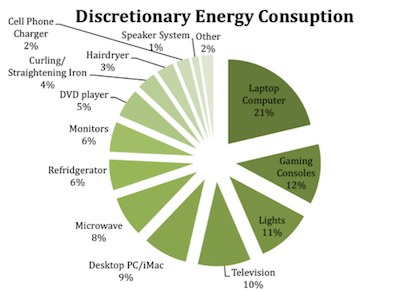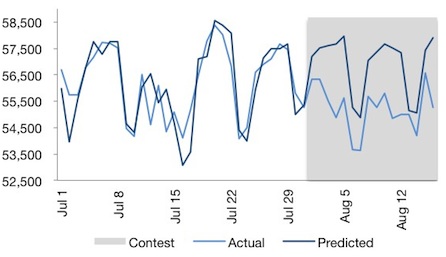Energy competitions, in which the occupants of different buildings battle to reduce their demand, remain enduringly popular on college campuses and at corporations. I once thought these competitions were a bit silly, feel-good events with little practical relevance to energy use in large organizations. After helping a corporate client analyze the results of a recent competition, however, I’m changing my tune. But not for the reasons you might think.
What is wrong with energy competitions
There are two big reasons to be skeptical of energy competitions. The first is that they tend to encourage unsustainable behavioral change, not true energy efficiency. Properly defined, energy efficiency is the ability to deliver the same services with less expense or energy use. Energy competitions with cutesy names like “Do it in the Dark” instead usually involve radical but necessarily short-term reductions in energy consumption through large shifts in occupant behavior. After an initial boost, the savings quickly fade away. This is the main reason I can’t find a single utility that sponsors energy competitions.

Discretionary energy use in a college dorm.
Second, discretionary energy demand in most organizations is a small portion of total energy spend. On a high-tech campus, 90% of use might come from labs and data centers, leaving just a tiny amount attributable to occupant behavior. The highest number I have seen is from a fun study of residential dorms at SCU; their calculations indicate about about 44% of load in dorms is discretionary. What is not said is that this is likely to be well under 10% of the total campus load. The results from a survey (pdf) of competitions from the folks at Lucid show similar results; of 6 competitions, only one saved more than $10K. When most colleges are spending $2 million per year or more on energy, modest savings can’t justify the time and expense of organizing these competitions.
Why I changed my tune
We talk a lot at Gridium with clients about active energy management — the idea that as we transition to the smart grid, organizations that interact with the grid through price signals, demand response and energy markets can create value and savings. We have shown strong savings to date, typically 3-5% in a just a few weeks.
“Active” is of course the word that most clients struggle with. Active means making changes, often on the hottest days and potentially affecting the sacred cow of real estate operations — client satisfaction.

A solid energy model picks up even small behavioral changes on the main meter. The gap between actual and predicted use after the start of the contest clearly shows the effect of occupant behavioral change.
That’s why I’ve changed my tune. Energy competitions aren’t for saving energy; they are for engaging occupants in your challenge, finding advocates and establishing links with leadership that can help you drive programs. Want to shut down one of the elevators on a Peak Day Pricing day? If you’ve done an energy competition, you can highlight to those same participants how this action saves energy (and money). Want to raise temperatures in a server room? Go reach out to the software engineer that asked you all the questions about the energy competition. Pretty soon you’ll find the line between “behavior” and operational effectiveness blurring, and a fountain of savings ahead of you (for an academic survey see this ACEEE report).
Some tips for running good competitions
The key to a successful energy competition is keeping the team focused on the true objectives:
- Be honest about your goals: Someone is going to ask you along the way what all of this is going to save. Be honest and conservative and stress that this is about engagement and communication.
- Be sure you can measure the effects: Users will want honest feedback about how they did. You should be armed with good models that can isolate user feedback, even with low levels of discretionary load. These aren’t expensive; typically $500 will buy you a good regression model (pictured) sensitive enough to pick things up. Call us if you can’t find anyone.
- Drive specific behavior: Are you trying to make a drive to lower baseload? Communicate how important PC, copier, and lighting shutoff is after hours. This can help you make your case for management software or timing strips. If you have fume hoods, focus on sash closure, and justify a sensor investment.
- Communicate: put the effort into your emails and communication. Ask a sustainability committee or non-energy friend to review the copy. Great competitions send three emails: one announcing the competition, a mid-term update (with results) and a final email. People are both competitive and inquisitive, so budget time for feedback. Remember, these are the advocates for you in the organization, so build bridges to them.
- Analyze and incorporate: Were the results as expected? What dropped and why? Sometimes competitions can illuminate good sources of permanent reductions. Even if you expectations are modest, don’t overlook small wins.
- Repeat: We are all creatures of habit. If the competition was useful for user engagement, then plan a new one. Two a year should keep the message fresh
What other tips to you have? Experience from a designer or participant in an energy competition? Let us know in the comments.

Tom – I know you enjoy reading. I am going to reference the methodology used in the book ‘Switch: How to Change Things when Change is Hard’. Have you read it? As described in the book, if we seriously want to make a persistant change, we need to direct the rider and motivate the elephant. Your six steps for a good competition is great direction for the driver, but how do you motivate the elephant? How can you use emotion to drive change? Feeling good about energy savings is not a good enough motivator…unfortunately. If corporations or universities can generate a competition with a creative way to motivate the staff and direct goals/progress with your steps above, I think you are right, energy competitions can be successful.